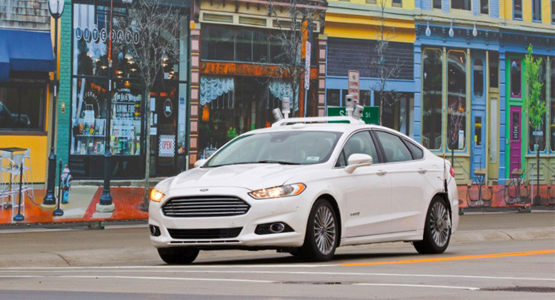Ford, Michigan Researchers Test First Autonomous Vehicle at Mcity
The scope of the project consists of a number of thrusts including a key research collaboration led by Profs. Edwin Olson and Ryan Eustice, who are playing a leading role in the development of the critical sensing and decision-making found in the Ford test vehicles.

 Enlarge
Enlarge
Michigan researchers, working with Ford Motor Company, have been the first to test a fully autonomous vehicle at the University’s Mcity test facility.
Ford made this announcement in a press release, in which they comment further on the progress of their autonomous vehicle project. The scope of the project consists of a number of thrusts including a key research collaboration led by Profs. Edwin Olson and Ryan Eustice, who are playing a leading role in the development of the critical sensing and decision-making found in the Ford test vehicles.
Both Prof. Olson and Prof. Eustice have deep experience in the areas of autonomy, robotics, and sensing for the development of autonomous systems.
Prof. Olson is the director of the APRIL Robotics Lab, which studies Autonomy, Perception, Robotics, Interfaces, and Learning. In 2010, he led the winning team in the MAGIC 2010 competition by developing a team of 14 robots that semi-autonomously explored and mapped a large-scale urban environment. In addition to the Ford project, he is currently leading development of a fleet of autonomous “SmartCarts;” a transportation-on-demand system built around autonomous vehicles.
Prof. Eustice is the director of the Perceptual Robotics Lab (PeRL), a mobile robotics laboratory focused on algorithm development in the areas of robotic perception, navigation, and mapping. His active research projects include applications to autonomous underwater ship hull inspection, multi-vehicle cooperative underwater navigation, benthic high-resolution mapping, and automotive active safety and self-driving capabilities.
For the Ford project, the two are employing Velodyne laser range finders, cameras, radars, and other sensors for use in developing 3-D environmental maps and for monitoring and responding to traffic conditions, as well as the artificial intelligence that controls the decision making based on this input.
Below is a video released by Ford which shows a test vehicle operating autonomously on the Mcity test track. The video includes examples of the 3-D environment built by the vehicle’s sensing system.
The Mcity test facility opened in July. Its full-scale urban environment provides real-world road scenarios – such as running a red light – that can’t be replicated on public roads. There are street lights, crosswalks, lane delineators, curb cuts, bike lanes, trees, hydrants, sidewalks, signs, traffic control devices – even construction barriers.
 MENU
MENU 
